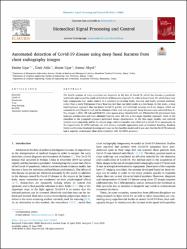| dc.contributor.author | Uçar, Emine | |
| dc.contributor.author | Atilla, Ümit | |
| dc.contributor.author | Uçar, Murat | |
| dc.contributor.author | Akyol, Kemal | |
| dc.date.accessioned | 2021-07-09T06:31:34Z | |
| dc.date.available | 2021-07-09T06:31:34Z | |
| dc.date.issued | 2021 | en_US |
| dc.identifier.citation | Uçar, E., Atila, Ü., Uçar, M., & Akyol, K. (2021). Automated detection of Covid-19 disease using deep fused features from chest radiography images. Biomedical signal processing and control, 69, art. no, 102862.
https://doi.org/10.1016/j.bspc.2021.102862 | en_US |
| dc.identifier.uri | https://doi.org/10.1016/j.bspc.2021.102862 | |
| dc.identifier.uri | https://hdl.handle.net/20.500.12508/1860 | |
| dc.description.abstract | The health systems of many countries are desperate in the face of Covid-19, which has become a pandemic worldwide and caused the death of hundreds of thousands of people. In order to keep Covid-19, which has a very high propagation rate, under control, it is necessary to develop faster, low-cost and highly accurate methods, rather than a costly Polymerase Chain Reaction test that can yield results in a few hours. In this study, a deep learning-based approach that can detect Covid-19 quickly and with high accuracy on X-ray images, which are common in every hospital and can be obtained at low cost, was proposed. Deep features were extracted from X-Ray images in RGB, CIE Lab and RGB CIE color spaces using DenseNet121 and EfficientNet B0 pre-trained deep learning architectures and then obtained features were fed into a two-stage classifier approach. Each of the classifiers in the proposed approach performed binary classification. In the first stage, healthy and infected samples were separated, and in the second stage, infected samples were detected as Covid-19 or pneumonia. In the experiments, Bi-LSTM network and well-known ensemble approaches such as Gradient Boosting, Random Forest and Extreme Gradient Boosting were used as the classifier model and it was seen that the Bi-LSTM network had a superior performance than other classifiers with 92.489% accuracy. | en_US |
| dc.language.iso | eng | en_US |
| dc.publisher | Elsevier | en_US |
| dc.relation.isversionof | 10.1016/j.bspc.2021.102862 | en_US |
| dc.rights | info:eu-repo/semantics/openAccess | en_US |
| dc.subject | Automatic medical diagnosis | en_US |
| dc.subject | Bi-LSTM | en_US |
| dc.subject | Covid-19 | en_US |
| dc.subject | Deep learning | en_US |
| dc.subject | Pneumonia | en_US |
| dc.subject | X-ray | en_US |
| dc.subject.classification | Radiological Findings | |
| dc.subject.classification | Clinical Features | |
| dc.subject.classification | COVID-19 | |
| dc.subject.other | Costs | |
| dc.subject.other | Decision trees | |
| dc.subject.other | Long short-term memory | |
| dc.subject.other | Polymerase chain reaction | |
| dc.subject.other | X ray radiography | |
| dc.subject.other | Automated detection | |
| dc.subject.other | Automatic medical diagnose | |
| dc.subject.other | Bi-LSTM | |
| dc.subject.other | Chest radiography | |
| dc.subject.other | Covid-19 | |
| dc.subject.other | Deep learning | |
| dc.subject.other | Gradient boosting | |
| dc.subject.other | Low-costs | |
| dc.subject.other | Pneumonia | |
| dc.subject.other | X-ray image | |
| dc.subject.other | Diagnosis | |
| dc.title | Automated detection of Covid-19 disease using deep fused features from chest radiography images | en_US |
| dc.type | article | en_US |
| dc.relation.journal | Biomedical Signal Processing and Control | en_US |
| dc.contributor.department | İşletme ve Yönetim Bilimleri Fakültesi -- Yönetim Bilişim Sistemleri Bölümü | en_US |
| dc.identifier.volume | 69 | en_US |
| dc.relation.publicationcategory | Makale - Uluslararası Hakemli Dergi - Kurum Öğretim Elemanı | en_US |
| dc.contributor.isteauthor | Uçar, Emine | |
| dc.contributor.isteauthor | Uçar, Murat | |
| dc.relation.index | Web of Science - Scopus - PubMed | en_US |
| dc.relation.index | Web of Science Core Collection - Science Citation Index Expanded | |
















